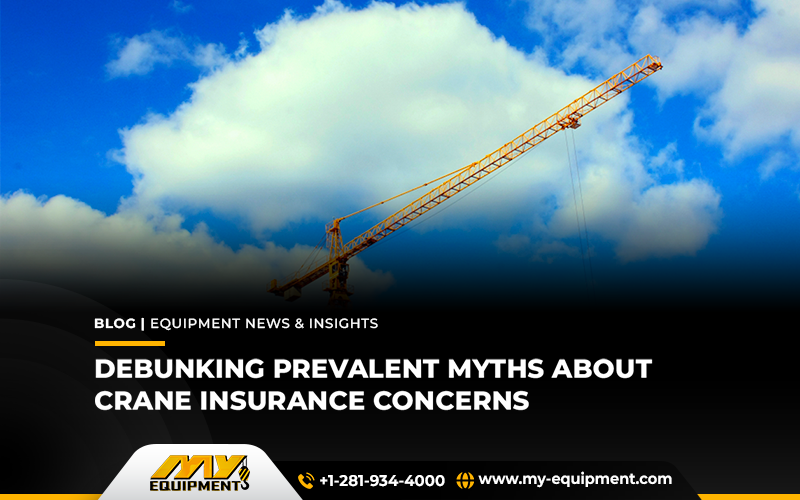“An ounce of prevention is worth a pound of cure.” — Benjamin Franklin
This is a common phrase that we all have heard often. It says that you must take preventive measures early to avoid the expenses of costly cures. It is true in all essence whether it is about your overall health or equipment insurance.
Understanding the complexity of crane insurance can be difficult, especially given the industry-specific lingo and numerous myths that can cause confusions. Understanding how insurance policies operate is essential for crane operators and business owners to guarantee proper coverage and prevent needless costs. Once you understand the intricacies of the matter, you will better be able to solve the issues. This is what Benjamin’s statement means.
Misconception 1
If my equipment is taken together, the insurance company will pay the amount specified on my policy.
A common myth about crane insurance is that insurers will pay out based on the declared values that policyholders have provided in case of a total loss. To better understand this theory, you must understand the Actual Cash Value (ACV) and Replacement Cost Value (RCV).
Replacement Cost Value (RCV) vs. Actual Cash Value (ACV)
Generally, insurance plans are created using either an ACV or an RCV basis which many people do not understand. Sometimes the insurance firm also fraud the client by taking advantage of the situation.
Actual Cash Value (ACV) is the purchase price of the asset less any depreciation. Put another way, in case your crane is lost or damaged, the insurance provider will pay you back for the crane’s market worth at the time of the loss, taking into consideration uselessness or wear and tear.
Under the Replacement Cost Value (RCV) policy, the insurer must pay the full cost of a new, comparable-quality crane to replace the damaged one, without subtracting any depreciation.
Now you must remember that rates are determined mostly by the reported worth of the equipment rather than by the amount of claims. Policyholders wind up paying more for their coverage than necessary if the stated value is greater than the ACV or RCV, but they do not get paid more in the event of a claim. On the other hand, the insurance company will typically pay a smaller amount if the declared value is less than the actual worth.
Precisely determining the equipment values
Policyholders must set values that appropriately reflect the genuine value of their equipment to guarantee fair pricing and payments. Some firms do not even allow crane owners to put their cranes for rent until the insurance claim is successfully resolved. They pay a reasonable premium and, in the event of a claim, obtain just recompense by doing this. An error that results in higher insurance costs without commensurate benefits is overstating values in the hopes of receiving a larger claim.
Misconception 2
After my claim is paid, insurance companies are too sluggish to replace it.
Another common misconception is that insurance companies will not seek replacement once a claim has been settled. Although this may be the case for certain carriers, the truth is that subrogation is typically the most advantageous option for both the policyholder and the insurer when it comes to recovering losses.
What is subrogation?
The process through which an insurance company, after paying a claim to the policyholder, pursues recovery from the entity accountable for the loss is known as subrogation. This process helps the insurer recover its losses while also potentially lowering future premiums and loss ratios for the policyholder.
Active policyholder participation
Only smart and strategic approaches can help the policyholders to smoothly go through this subrogation process. Providing relevant information and contacts helps speed up the recovery process because the crane firm involved in the claim is probably more familiar with the specifics and the people involved than the insurance company. Even small steps, such as exchanging contact details with the accountable party or gathering evidence to support your case, can have a big impact.
How does a broker help?
Policyholders should not be reluctant to contact their brokers if they have any questions or concerns. Brokers are available to offer precise answers and help and possess the knowledge and experience necessary to handle complicated insurance issues. Sharing all the details of the claims and keeping the broker in the loop throughout the process, will help you a lot. This is one of the main reasons you should always contact tot eh trustworthy broker when buying cranes or any other heavy equipment. Only the trusted and licensed brokers are most familiar with the overall process and happy to help the clients.
Endnote
Business owners and operators need to understand the nuances of crane insurance to steer clear of typical hazards and make sure they are sufficiently covered. Crane operators can secure equitable compensation in the event of a claim, reduce premium costs, and make well-informed decisions by dispelling common myths and promoting a clear grasp of policy terms. To optimize your insurance coverage, always remember to appropriately value your equipment and take an active part in the subrogation process.
When you contact MY Equipment for our exclusive crane rental services, you can expect top-tier cranes from leading brands and unmatched customer support. We are a Houston-based used equipment dealer and crane rental, aiming to provide you with the best used equipment at reasonable prices. Contact us now for all your equipment queries.


 1400 Broadfield Blvd, Houston, TX 77084,
USA.
1400 Broadfield Blvd, Houston, TX 77084,
USA. omer@my-equipment.com
omer@my-equipment.com